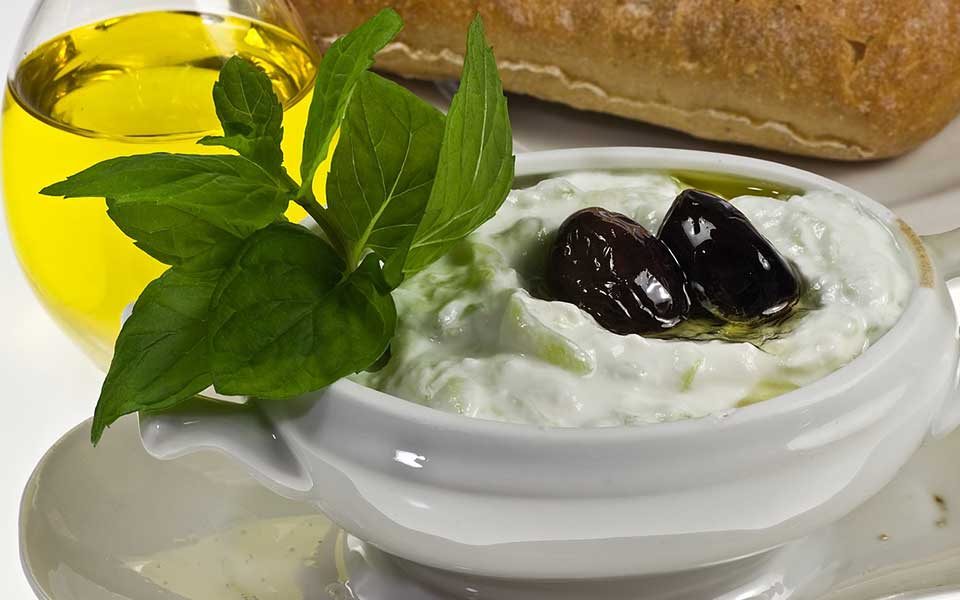Paros: 12 Culinary Stops on a Cycladic Favorite
From kafeneia serving souma and meze...

Greek yogurt with figs and honey aka "The Breakfast of Champions" - James Bond’s breakfast of choice in “From Russia with Love.”
© Jane Rix / Shutterstock
Traditional Greek yogurt is made of pure sheep’s milk strained in a muslin cloth bag to remove the whey (the liquid byproduct). This process gives it a much thicker, creamier consistency compared to natural, unstrained yogurt, and a much richer, tangier taste.
Packed with calcium and protein, the straining process also removes some of the lactose, making it lower in sugar than regular yogurt.
As Greek yogurt has grown in popularity far beyond the borders of Greece, large-scale dairy manufacturers have switched to using cow’s milk to keep up with demand, but the time-honored formula of straining and fermentation remains the same.
All yogurt is made by fermenting milk with live cultures of beneficial bacteria known as “yogurt cultures,” but the reduced sugar content of traditional Greek yogurt makes it a healthier option. As such, it is often used in recipes as a healthier substitute to mayonnaise, sour cream or crème fraîche.
Rich in calcium, eating Greek yogurt can improve bone health and reduce the risk of osteoporosis, a degenerative bone disease. It is also an excellent source of protein, which can boost metabolism and reduce appetite. Research has also shown that a high-protein diet can increase muscle mass in people doing weight (resistance) training.
Greek yogurt also contains iodine which helps support thyroid health and metabolic rate (the speed at which chemical reactions take place in the body) and also helps keep cells healthy.
Yogurt is also associated with probiotics, good bacteria that can restore healthy bacterial balance within the gut. Remarkably, studies have shown that probiotic yogurt can also encourage good mental health, too, reducing stress, depression and anxiety. This is likely due to the connections between the gut and brain, and the gut’s ability to produce neurotransmitters like serotonin and dopamine – hormones that modulate cognition and mood. Some research suggests probiotics found in fermented milk can also help reduce blood pressure.
Bottom line, eating a moderate amount of Greek yogurt as part of a balanced diet can be a great way to boost overall health and well-being. Paired with seasonal fruits, nuts and a drizzle of Greek mountain honey, it can be the perfect way to start the day or enjoyed as a healthy snack.

Homemade strained yogurt hanging in a cloth in the kitchen.
© Picture Partners / Shutterstock

Greek yogurt with honey in a white blue pot.
© thelefty / Shutterstock
Prehistorians believe early versions of yogurt or a yogurt-like product was first developed in the Neolithic Near East, some 7,000 years ago. Likely discovered by chance, one origin story points to Mesopotamian herders storing milk in goatskin bags. The combination of the intestinal juices from the bag and the heat from the desert caused the milk to ferment, producing a thick, creamy substance that resembled yogurt.
In ancient Greece, goat and sheep’s milk was a regular source of protein and calcium in a diet that, for many, featured little meat. But without refrigeration milk turns sour, so the Greeks developed something called “oxygala.”
Oxygala – oxi meaning “sour” and gala “milk” – an early type of yogurt derived from sour milk. The 2nd century AD Greek physician Galen wrote that it was thick and usually eaten with honey – just as Greek yogurt is today.
Over the past few decades, as more and more people get hooked on its thick, creamy, tangy taste, Greek yogurt has exploded in popularity around the world. Family-owned Greek dairy company FAGE (Φάγε – meaning Eat!), founded in Athens in 1926, first introduced their recipe of strained yogurt to the European market in 1981. FAGE Total, their first commercial yogurt, proved to be a huge success, especially in Italy and the UK. In the 1990s, exports to America kicked off the Greek yogurt craze, thanks to its nutritional advantages over normal, unstrained yogurt.
Forty years later, the world’s love affair with Greek yogurt continues unabated. With the increasing popularity of the Greek/Mediterranean diet abroad, year-on-year sales of classic Greek white yogurt to international supermarket chains show no sign of slowing down. In fact, the popularity of Greek yogurt has encouraged international manufacturers to produce their own brands of “Greek-style” yogurt, made with locally-sourced ingredients (e.g. Tesco’s Greek Style Yoghurt with 100% British milk or Farmer’s Union Greek Style Natural Yoghurt in Australia).
Nevertheless, there’s a significant difference between authentic Greek yogurt and it’s “Greek-style” alternative. The latter often contains artificial thickeners such as gelatin and gum to replicate that thick, creamy texture. Greek-style yogurt also contains more preservatives to increase shelf life. As such, it’s better to go with the real deal – all-natural ingredients and no additives.

Tzatziki with olives and a spearmint garnish, served as meze.
© Nikodem Nijaki
Greek yogurt isn’t only good for your gut, it’s also good for your skin! In fact, Greeks have long known about the incredible cosmetic benefits of using yogurt in their daily skincare routines. The lactic acid found in yogurt can help to shrink pores and diminish the appearance of wrinkles and fine lines, while Vitamin B and probiotics keeps the skin hydrated and promote cell-renewal. Protein, whether in our diet or in the skin products we use, also helps to bind, nourish and repair damaged skin tissue. As Greek yogurt boasts twice as much protein as regular yogurt, Greeks have been using it to keep their skin younger and more radiant-looking for centuries.
From sun cream to moisturising face serum, Athens-based natural brand Korres have introduced a line of products using Greek yogurt as their main component.
Greek yogurt is the base ingredient of tzatziki, commonly served as part of a traditional meze and usually eaten with bread, fried eggplant, or zucchini. It’s also a popular side dish to have at fish tavernas – try it with a plate of fried calamari. Perfect.
The traditional mix includes yogurt (usually from sheep or goat milk) with finely-chopped cucumbers, garlic, a pinch of salt and a drizzle of olive oil. Variations include adding a squeeze of lemon juice, some chopped dill, mint or parsley.
Tzatziki often appears in a souvlaki pita – grilled souvlaki meat, usually pork, wrapped in a pita bread with chopped tomatoes, onions, and fried potatoes.
If for some reason it is not possible to find a pot of Greek yogurt at the local store or supermarket, simply pour regular yogurt into cheesecloth and strain it for several hours over a container. The result will be much thicker and creamier, resembling Greek-style yogurt, and the leftover whey can be used to cook pasta, potatoes or rice to add more flavour!
From kafeneia serving souma and meze...
Among the many city eateries offering...
A closer look at the powerful,...